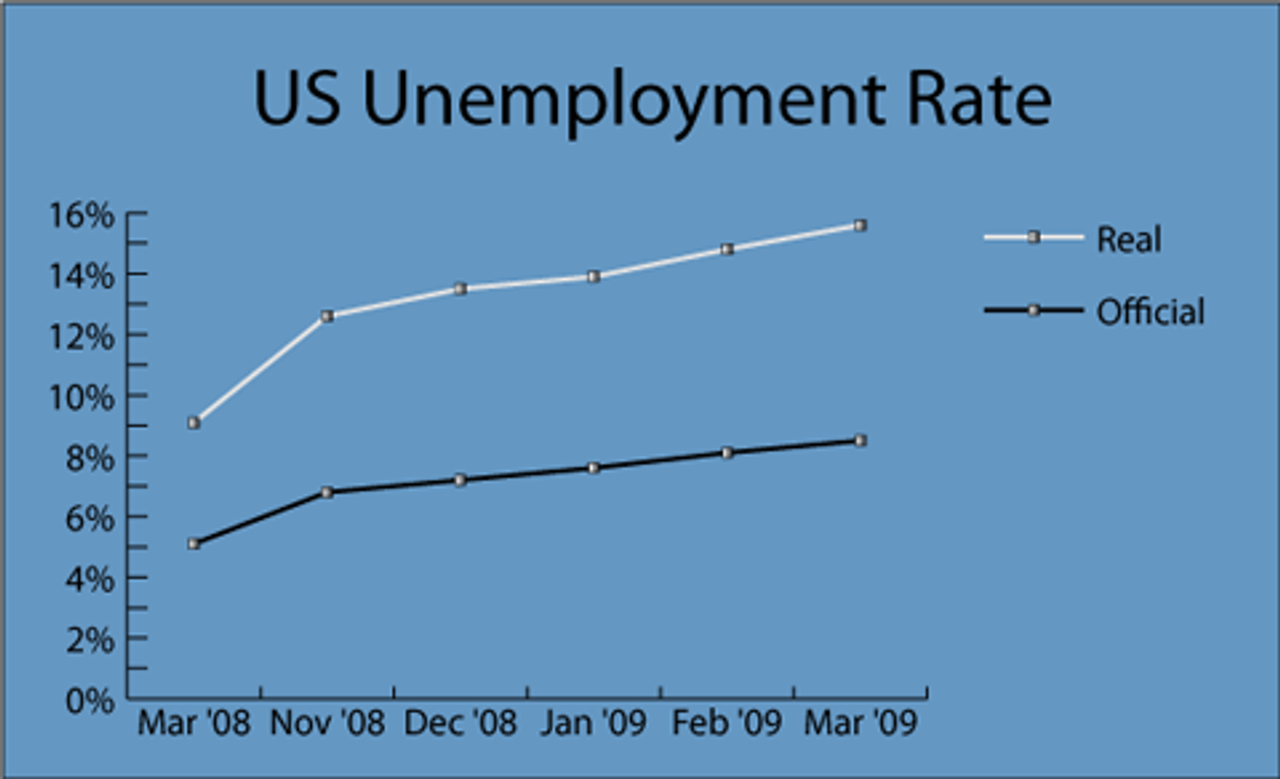The US unemployment rate reached 8.5 percent in March, its highest level since 1983, according to figures released Friday by the Labor Department.
The economy lost 663,000 jobs last month, bringing total losses since the beginning of the current recession to 5.1 million. Nearly two thirds of those job losses occurred in the past five months.
The total number of unemployed people increased by 694,000 to 13.2 million, the highest absolute number on record (not taking into account population growth).
Every sector other than education and health services saw job losses in March. Manufacturing lost 161,000 jobs and construction 126,000. The service sector was as badly affected, losing a total of 358,000 jobs. Professional and business services sector lost the most jobs of the entire service sector: 133,000 jobs. Retail lost 48,000 jobs, while leisure and hospitality lost 40,000.
The Labor Department also announced that it has revised upward its job loss figure by 86,000 for the month of January, putting total losses for that month at 741,000. February's figure was also revised upward by 9,000, to 706,000.
Initial weekly jobless claims rose to 669,000 last week, according to figures released Thursday.
The current downturn has in many respects exceeded every recession since the Second World War and is approaching the severity of the Great Depression. It is already the longest downturn of the post-war period, and has seen a larger number of job losses than any downturn since that of 1929-32.
The official unemployment rate tells only part of the story, since it takes into account only people who are both unemployed and actively looking for work. The number of discouraged workers—those willing to work who have not looked for a job in the past four weeks—reached 2.1 million in March, up by 754,000 from a year earlier.

The number of people working part-time because they cannot get a full-time job has risen by nearly 80 percent in the past year, hitting 8.6 million in February and 9 million in March. The figure increased by 423,000 last month.
If one adds discouraged workers and those working part-time "for economic reasons" to the official number of unemployed, one gets a more accurate picture of conditions facing workers. The Labor Department's U-6 unemployment rate—often referred to as the "real unemployment rate," which takes into account both discouraged and underemployed workers—hit 15.6 percent in March, the highest on record dating to 1994.
This index has risen much faster than the official unemployment rate, as workplaces cut hours and those laid off from stable work are forced to look for part-time work. In another sign of the deepening slump, the average workweek fell 0.1 hours in March to 33.2 hours, reaching the lowest level since records began in 1964.
The current rate of unemployment is already approaching government projections for the whole of 2009. At the beginning of the year the Federal Reserve estimated that the unemployment rate would only reach 8.5 to 8.8 percent by the end of the year before falling off. The "adverse" scenario being employed by the Treasury Department in conducting its "stress tests" of banks envisions an unemployment rate of 8.9 percent. At the current rate, the unemployment rate will exceed both of those levels next month, and will hit 12.1 percent by the end of this year.
William Gross, head of the bond investment fund Pimco, told CNBC that the unemployment rate is likely to jump to double digits. "Perhaps the more staggering number, in my opinion, is the five million jobs lost over the last 15 months," he said. "That's a lot of jobs, and a lot of jobs to recoup. Obama's goal, of course, is three-and-a-half-million jobs, either regained or saved."
Seven states now have unemployment rates of ten percent or higher, and more than fifteen counties report unemployment rates topping 20 percent. One measure of the mounting social impact of the slump is a recent government report that 32.2 million people, or one in ten US residents, are now receiving food stamps.
The downturn is creating a social disaster. So many people have been displaced by the foreclosure crisis that the Census Bureau is developing new methods of counting people living in "unconventional" housing. Terry-Ann Lowenthal, a census consultant, told the Financial Times: "Many people now who have lost their homes to foreclosure are doubling up with relatives, with other families. They might be living in motels... tent cities are popping up."
The scale and pace of job-destruction shed light on the token character of the so-called stimulus measures enacted by the Obama administration. The administration's fiscal plan was designed not to provide serious relief to the millions who are being hit by layoffs, the collapse of their retirement accounts and home foreclosures, but rather to put a floor under consumer spending to cushion the impact of the crisis on the banks. At the same time, it was crafted to provide political cover for the massive government bailout of Wall Street, which, according to recent estimates, has already consumed over $12 trillion in taxpayer monies, loans and government guarantees. This is about 15 times the size of the stimulus package.
Meanwhile, the administration is orchestrating a brutal restructuring of the US auto industry that will eliminate tens of thousands of jobs, gut pensions and health benefits, and impose poverty level wages on the remaining workers.
